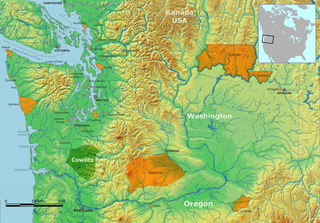Salishan oral narratives consist of the body of traditional narratives of the speakers of the Salishan languages, who inhabit British Columbia, Canada and in Washington, Idaho and Montana in the United States. Each of the many peoples in these groups have their own stories and each storyteller may interpret them in their own ways, but many of the stories of the Salish peoples are similar and share themes and characters, and share their historical origins in the proto-Salishan culture long ago. The earliest descriptions of the oral traditions of Salishan peoples were the collections of Nuxalk mythology by anthropologist Franz Boas collected in the water

Moclips is an unincorporated community and census-designated place (CDP) in Grays Harbor County, Washington, United States. The population was 207 at the 2010 census. It is located near the mouth of the Moclips River.

The Chehalis people or Tsihalis are a native people of western Washington state in the United States. They should not be confused with the similarly named Chehalis First Nation of the Sts'Ailes people along the Harrison River in the Fraser Valley area of British Columbia.

The term Cowlitz people covers two cultural and by language distinct indigenous peoples of the Pacific Northwest; the Lower Cowlitz or Cowlitz proper, a southwestern Coast Salish people, which today are enrolled in the federally recognized tribes: Cowlitz Indian Tribe, Quinault Indian Nation, and Confederated Tribes of the Chehalis Reservation; and the Upper Cowlitz / Cowlitz Klickitat or Taitnapam, a Northwest Sahaptin speaking people, part of the Confederated Tribes and Bands of the Yakama Nation.

A pharyngeal consonant is a consonant that is articulated primarily in the pharynx. Some phoneticians distinguish upper pharyngeal consonants, or "high" pharyngeals, pronounced by retracting the root of the tongue in the mid to upper pharynx, from (ary)epiglottal consonants, or "low" pharyngeals, which are articulated with the aryepiglottic folds against the epiglottis in the lower larynx, as well as from epiglotto-pharyngeal consonants, with both movements being combined.

The Willapa River is a river on the Pacific coast of southwestern Washington in the United States, approximately 20 miles (32 km) long. It drains an area of low hills and a coastal plain into Willapa Bay, a large estuary north of the mouth of the Columbia River.

The Chinookan languages were a small family of languages spoken in Oregon and Washington along the Columbia River by Chinook peoples. All are now extinct, although Upper Chinook had 270 self-identified speakers in 2009-2013.
The Skagit are either of two tribes of the Lushootseed Native American people living in the state of Washington, the Upper Skagit and the Lower Skagit.
The Thompson language, properly known as Nlaka'pamuctsin also known as the Nlaka'pamux ('Nthlakampx') language, is an Interior Salishan language spoken in the Fraser Canyon, Thompson Canyon, Nicola Country of the Canadian province of British Columbia, and also (historically) in the North Cascades region of Whatcom and Chelan counties of the state of Washington in the United States. A dialect distinctive to the Nicola Valley is called Scw'exmx, which is the name of the subgroup of the Nlaka'pamux who live there.
Lillooet, also known as St’át’imcets, is the language of the St’át’imc, a Salishan language of the Interior branch spoken in southern British Columbia, Canada, around the middle Fraser and Lillooet Rivers. The language of the Lower Lillooet people uses the name Ucwalmícwts, because St’át’imcets means "the language of the people of Sat̓", i.e. the Upper Lillooet of the Fraser River.

The Confederated Tribes of the Chehalis Reservation is a federally recognized tribe of Upper and Lower Chehalis, Klallam, Muckleshoot, Nisqually, and Quinault peoples. They are one of the Northern Straits branch Central Coast Salish peoples of indigenous peoples of the Northwest Coast. Their tribe is located in southwest Washington.
M. Dale Kinkade (1933–2004) was a linguist known especially for his work on Salishan languages.
The Cowlitz language is a member of the Tsamosan branch of the Coast Salish family of Salishan languages.
The Willapa or Willoopah, also known as Kwalhioqua, were a Northern Athapaskan-speaking people in southwestern Washington, United States. Their territory was the valley of the Willapa River and the prairie between the headwaters of the Chehalis and Cowlitz Rivers.
The Salish peoples are an ethno-linguistic group of the Pacific Northwest, identified by their use of the Salish languages which diversified out of Proto-Salish between 3,000 and 6,000 years ago.

The Cowlitz Indian Tribe is a federally recognized tribe of Cowlitz people. They are a tribe of Southwestern Coast Salish and Sahaptan people indigenous people of the Pacific Northwest located in Washington. The tribe is named for the Cowlitz River.
This page is based on this
Wikipedia article Text is available under the
CC BY-SA 4.0 license; additional terms may apply.
Images, videos and audio are available under their respective licenses.







